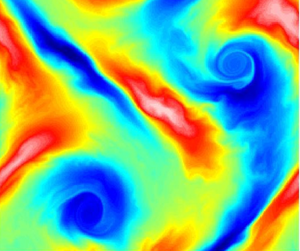Published online by Cambridge University Press: 30 April 2024

The parameterization of fluxes associated with representing unresolved dynamics in turbulent flows, especially in the atmosphere and ocean (which have a vast range of scales), remains a challenging task. This is especially true for Earth system models including complex biogeochemistry and requiring very long simulations. The problem of representing the dependence of the mean flux of a passive tracer in terms of the mean has a very long history; in this study, we take a somewhat different approach. We use a formalism showing that the mean flux will be a functional of the mean gradients, a formalism that can be used to calculate the structure of the functional which is non-local in both space and time. Two-dimensional turbulent simulations are used to explore the weight of nearby (in space or time) gradients. We also use stochastic velocities and iterated maps to show that the results are similar. The functional formalism provides an understanding of when non-locality needs to be considered and when a local eddy diffusivity can be a reasonably good approximation. Furthermore, the formalism provides guidance for the development of data-driven parameterizations.
To send this article to your Kindle, first ensure no-reply@cambridge.org is added to your Approved Personal Document E-mail List under your Personal Document Settings on the Manage Your Content and Devices page of your Amazon account. Then enter the ‘name’ part of your Kindle email address below. Find out more about sending to your Kindle. Find out more about saving to your Kindle.
Note you can select to save to either the @free.kindle.com or @kindle.com variations. ‘@free.kindle.com’ emails are free but can only be saved to your device when it is connected to wi-fi. ‘@kindle.com’ emails can be delivered even when you are not connected to wi-fi, but note that service fees apply.
Find out more about the Kindle Personal Document Service.
To save this article to your Dropbox account, please select one or more formats and confirm that you agree to abide by our usage policies. If this is the first time you used this feature, you will be asked to authorise Cambridge Core to connect with your Dropbox account. Find out more about saving content to Dropbox.
To save this article to your Google Drive account, please select one or more formats and confirm that you agree to abide by our usage policies. If this is the first time you used this feature, you will be asked to authorise Cambridge Core to connect with your Google Drive account. Find out more about saving content to Google Drive.